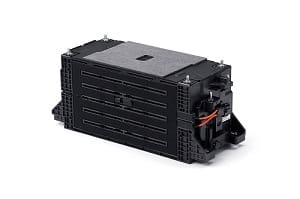The halogen-free, flame-retardant and glass-fibre-reinforced module meets stringent mechanical and chemical property requirements

Speciality chemicals company LANXESS and Korean auto parts specialist INFAC have together developed a battery module housing for electric vehicles (EVs).
The battery housing uses Durethan BKV30FN04 from LANXESS to satisfy stringent mechanical and chemical property requirements for the latest EV components. The halogen-free, flame-retardant and glass-fibre-reinforced polyamide 6 (PA6) is characterised by its excellent flame-retardant and electrical properties. The material is highly processable and enables the integration of complex functions required for housing components, resulting in a smaller number of parts and a simplified assembly process as well as lighter weight.
The new battery housing part has been adopted to series production of EV models launched by a Korean OEM this year. “Success in mass production of battery housing demonstrates LANXESS Durethan’s excellence in EV batteries, in which technology and safety are of utmost importance. Our high-performance plastics will make a significant contribution to the EV and battery markets,” Milan Vignjevic, head of LANXESS’ High-Performance Materials (HPM) business unit in Asia-Pacific, says.
Flame retardant with good mechanical and electrical characteristics
For the battery module housing, shock absorption and thermal management are critical to protecting the battery from external shock. Durethan BKV30FN04 is not only mechanically robust but also boasts high-voltage insulation, resistant to up to 800 V and effectively blocking high-voltage current. With strong flame-retardant properties, it prevents or delays flames from spreading in case of a fire. Glass-fibre reinforced Durethan BKV30FN04’s durability to mechanical loads is superior to unfilled PA6.
Furthermore, it maintains excellent strength and stiffness when in contact with electrolyte or cooling media, and has chemical resistance to suppress chemically-induced damage.
LANXESS’ engineering plastics can be applied to a wide range of battery components including battery covers, high-voltage connectors, cable brackets and battery cell cooling system pipes as well as parts for hydrogen fuel cell vehicles such as hydrogen storage tanks. It can also replace metals in various components, enabling lightweight design. It allows to produce several functional components in one process, a driver behind continuous growth in demand in the next generation mobility market where many technologies and components come into play.
“High-quality materials, technical expertise and customized engineering services from LANXESS enabled us to speed up our development. This helped solidify our position in the fast-evolving EV battery parts market,” Gyuso Lee, Head of Purchasing & Development at INFAC, says.
Sanghun Han, Head of HPM in Korea, says, “LANXESS has closely cooperated with globally leading automotive OEMs, including from Korea. That is why we were able to identify the trends and the challenges of e-mobility at an early stage and participate in various EV and battery development projects. With accumulated success stories with our customers, we are establishing ourselves as a key material partner in new mobility.”







